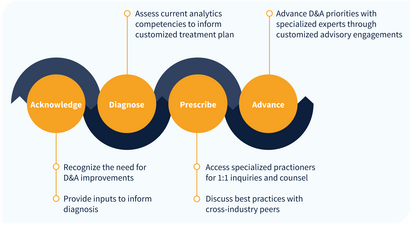Client Inquiry:
We’re building a new shared service for data and analytics and looking for strategy advice for year one.
Expert Takeaways:
Delivering Initial Value
Building infrastructure, process, methods, and practices is a long-cycle activity. For year one, split your effort into two buckets: bucket one is value now, and bucket two is infrastructure, processes, methods, and practices. For bucket one:
- In the first 30–60 days, go on a roadshow to key influencers on the demand side to gain an aggregated view of the existing demand. This is a view of pent-up demand.
- Focus your resources on three projects, at most, that you believe can get to at least pilots, if not proofs of concepts. The goal is to create success stories to prove your value and make data and analytics tangible to the business.
- Think of the projects as throwaways. It’s okay to deliver value using makeshift methods and practices while you get to a working hypothesis (bucket two).
- At the end of year one, when you go to the executive team with your multi-year budgeted roadmap, you’ll already have delivered value.
- In addition, getting those projects into pilot will reveal the broader and deeper organizational and process challenges that you’ll have to deal with.
Operating and Lifecycle Models
Working in parallel with bucket one, bucket two is about building the infrastructure, process, methods, and practices to perform data and analytics at scale.
- First, decide on the operating model. Wherever you start, over time, everybody graduates to federated operating models with both centralized resources and distributed or embedded resources.
- What does federated look like? Which resources are centralized and which are distributed? How much control does the centralized team have over the distributed teams?
- You need lifecycle models. Look at roles, responsibilities, and expectations across the lifecycle of an analytical application project or a data provisioning project. Separate data productization and provisioning from analytics development and delivery.
- What do the various parts of the federated organization do in each stage of the life cycle? When do you involve the business, system owners, legal, privacy, records management, and other constituencies?
- As soon as you have a hypothesis about the way something is going to work, push it into the implementation side—to the teams who will use it—to test the hypothesis.
Common Platform
Think about the common platform as the middle. To the left are the processes and tooling to produce data products. To the right, downstream, is the analytical application lifecycle. Continuing with bucket two:
- What does the construction of a data product look like? Who’s responsible for it? What’s the expectation about what data products should look like? The way that data products get produced, moved, staged, and cataloged must be 100% standardized.
- What does the common platform look like—data lake? cloud? both?—including data staging, governance structures, tools, and technologies that come with the platform that users can use to build their products.
- On the downstream side, you know what the distributed analytics teams can assume about the quality and availability of their data products. You’ve got a platform, so those teams also know what they have available to them.
- So then, what does the analytical application lifecycle look like? How do you identify opportunities for new project work? Curated demand is the beginning of the lifecycle and critical for delivering meaningful value consistently.
- The life cycle includes running experiments as quickly as possible to see whether you can build an application that will deliver value, getting a proof of concept in front of the business, and moving into the pilot stage.
- At the end of a successful pilot, don’t rush into production. Build in a commitment moment that says, okay, business, you’re telling us you want to roll this out; here’s what it’s going to cost you; can you commit to this?
“With the help of IIA Experts we were able to get multiple relevant perspectives on our issues quickly and efficiently without need for engaging expensive consultants.”
Expert Network
IIA provides guided access to our network of over 150 analytics thought leaders, practitioners, executives, data scientists, data engineers with curated, facilitated 1-on-1 interactions.
- Tailored support to address YOUR specific initiatives, projects and problems
- High-touch onboarding to curate 1-on-1 access to most relevant experts
- On-demand inquiry support
- Plan validation and ongoing guidance to advance analytics priority outcomes
- Monthly roundtables facilitated by IIA experts on the latest analytics trends and developments
